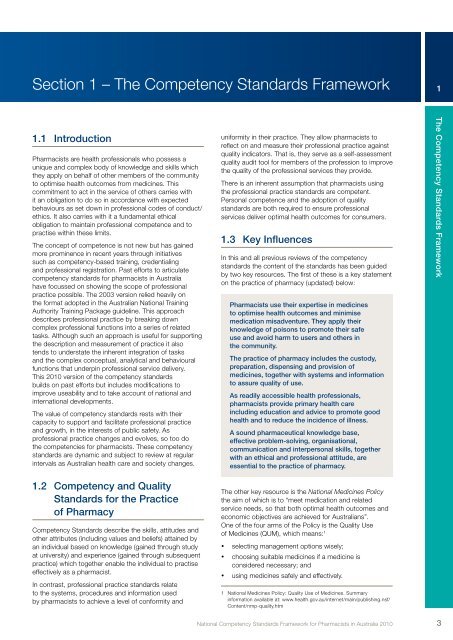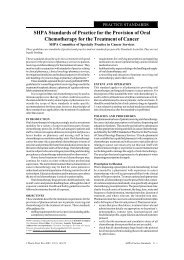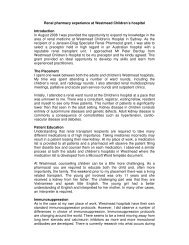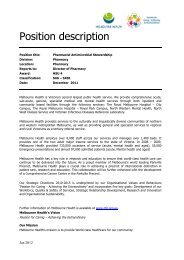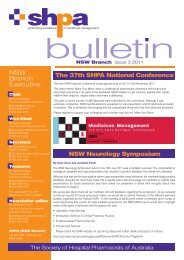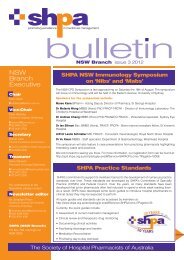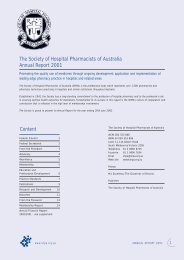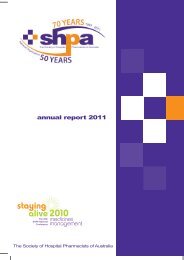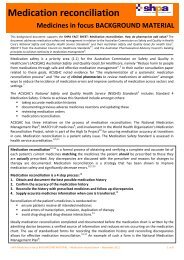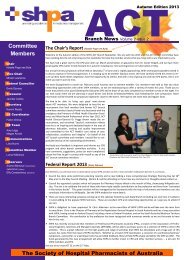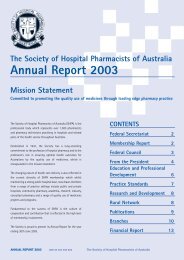National Competency Standards Framework for Pharmacists in ...
National Competency Standards Framework for Pharmacists in ...
National Competency Standards Framework for Pharmacists in ...
Create successful ePaper yourself
Turn your PDF publications into a flip-book with our unique Google optimized e-Paper software.
Section 1 – The <strong>Competency</strong> <strong>Standards</strong> <strong>Framework</strong><br />
1<br />
1.1 Introduction<br />
<strong>Pharmacists</strong> are health professionals who possess a<br />
unique and complex body of knowledge and skills which<br />
they apply on behalf of other members of the community<br />
to optimise health outcomes from medic<strong>in</strong>es. This<br />
commitment to act <strong>in</strong> the service of others carries with<br />
it an obligation to do so <strong>in</strong> accordance with expected<br />
behaviours as set down <strong>in</strong> professional codes of conduct/<br />
ethics. It also carries with it a fundamental ethical<br />
obligation to ma<strong>in</strong>ta<strong>in</strong> professional competence and to<br />
practise with<strong>in</strong> these limits.<br />
The concept of competence is not new but has ga<strong>in</strong>ed<br />
more prom<strong>in</strong>ence <strong>in</strong> recent years through <strong>in</strong>itiatives<br />
such as competency-based tra<strong>in</strong><strong>in</strong>g, credential<strong>in</strong>g<br />
and professional registration. Past ef<strong>for</strong>ts to articulate<br />
competency standards <strong>for</strong> pharmacists <strong>in</strong> Australia<br />
have focussed on show<strong>in</strong>g the scope of professional<br />
practice possible. The 2003 version relied heavily on<br />
the <strong>for</strong>mat adopted <strong>in</strong> the Australian <strong>National</strong> Tra<strong>in</strong><strong>in</strong>g<br />
Authority Tra<strong>in</strong><strong>in</strong>g Package guidel<strong>in</strong>e. This approach<br />
describes professional practice by break<strong>in</strong>g down<br />
complex professional functions <strong>in</strong>to a series of related<br />
tasks. Although such an approach is useful <strong>for</strong> support<strong>in</strong>g<br />
the description and measurement of practice it also<br />
tends to understate the <strong>in</strong>herent <strong>in</strong>tegration of tasks<br />
and the complex conceptual, analytical and behavioural<br />
functions that underp<strong>in</strong> professional service delivery.<br />
This 2010 version of the competency standards<br />
builds on past ef<strong>for</strong>ts but <strong>in</strong>cludes modifications to<br />
improve useability and to take account of national and<br />
<strong>in</strong>ternational developments.<br />
The value of competency standards rests with their<br />
capacity to support and facilitate professional practice<br />
and growth, <strong>in</strong> the <strong>in</strong>terests of public safety. As<br />
professional practice changes and evolves, so too do<br />
the competencies <strong>for</strong> pharmacists. These competency<br />
standards are dynamic and subject to review at regular<br />
<strong>in</strong>tervals as Australian health care and society changes.<br />
uni<strong>for</strong>mity <strong>in</strong> their practice. They allow pharmacists to<br />
reflect on and measure their professional practice aga<strong>in</strong>st<br />
quality <strong>in</strong>dicators. That is, they serve as a self-assessment<br />
quality audit tool <strong>for</strong> members of the profession to improve<br />
the quality of the professional services they provide.<br />
There is an <strong>in</strong>herent assumption that pharmacists us<strong>in</strong>g<br />
the professional practice standards are competent.<br />
Personal competence and the adoption of quality<br />
standards are both required to ensure professional<br />
services deliver optimal health outcomes <strong>for</strong> consumers.<br />
1.3 Key Influences<br />
In this and all previous reviews of the competency<br />
standards the content of the standards has been guided<br />
by two key resources. The first of these is a key statement<br />
on the practice of pharmacy (updated) below:<br />
<strong>Pharmacists</strong> use their expertise <strong>in</strong> medic<strong>in</strong>es<br />
to optimise health outcomes and m<strong>in</strong>imise<br />
medication misadventure. They apply their<br />
knowledge of poisons to promote their safe<br />
use and avoid harm to users and others <strong>in</strong><br />
the community.<br />
The practice of pharmacy <strong>in</strong>cludes the custody,<br />
preparation, dispens<strong>in</strong>g and provision of<br />
medic<strong>in</strong>es, together with systems and <strong>in</strong><strong>for</strong>mation<br />
to assure quality of use.<br />
As readily accessible health professionals,<br />
pharmacists provide primary health care<br />
<strong>in</strong>clud<strong>in</strong>g education and advice to promote good<br />
health and to reduce the <strong>in</strong>cidence of illness.<br />
A sound pharmaceutical knowledge base,<br />
effective problem-solv<strong>in</strong>g, organisational,<br />
communication and <strong>in</strong>terpersonal skills, together<br />
with an ethical and professional attitude, are<br />
essential to the practice of pharmacy.<br />
The <strong>Competency</strong> <strong>Standards</strong> <strong>Framework</strong><br />
1.2 <strong>Competency</strong> and Quality<br />
<strong>Standards</strong> <strong>for</strong> the Practice<br />
of Pharmacy<br />
<strong>Competency</strong> <strong>Standards</strong> describe the skills, attitudes and<br />
other attributes (<strong>in</strong>clud<strong>in</strong>g values and beliefs) atta<strong>in</strong>ed by<br />
an <strong>in</strong>dividual based on knowledge (ga<strong>in</strong>ed through study<br />
at university) and experience (ga<strong>in</strong>ed through subsequent<br />
practice) which together enable the <strong>in</strong>dividual to practise<br />
effectively as a pharmacist.<br />
In contrast, professional practice standards relate<br />
to the systems, procedures and <strong>in</strong><strong>for</strong>mation used<br />
by pharmacists to achieve a level of con<strong>for</strong>mity and<br />
The other key resource is the <strong>National</strong> Medic<strong>in</strong>es Policy<br />
the aim of which is to “meet medication and related<br />
service needs, so that both optimal health outcomes and<br />
economic objectives are achieved <strong>for</strong> Australians”.<br />
One of the four arms of the Policy is the Quality Use<br />
of Medic<strong>in</strong>es (QUM), which means: 1<br />
• select<strong>in</strong>g management options wisely;<br />
• choos<strong>in</strong>g suitable medic<strong>in</strong>es if a medic<strong>in</strong>e is<br />
considered necessary; and<br />
• us<strong>in</strong>g medic<strong>in</strong>es safely and effectively.<br />
1 <strong>National</strong> Medic<strong>in</strong>es Policy: Quality Use of Medic<strong>in</strong>es. Summary<br />
<strong>in</strong><strong>for</strong>mation available at: www.health.gov.au/<strong>in</strong>ternet/ma<strong>in</strong>/publish<strong>in</strong>g.nsf/<br />
Content/nmp-quality.htm<br />
<strong>National</strong> <strong>Competency</strong> <strong>Standards</strong> <strong>Framework</strong> <strong>for</strong> <strong>Pharmacists</strong> <strong>in</strong> Australia 2010 3


